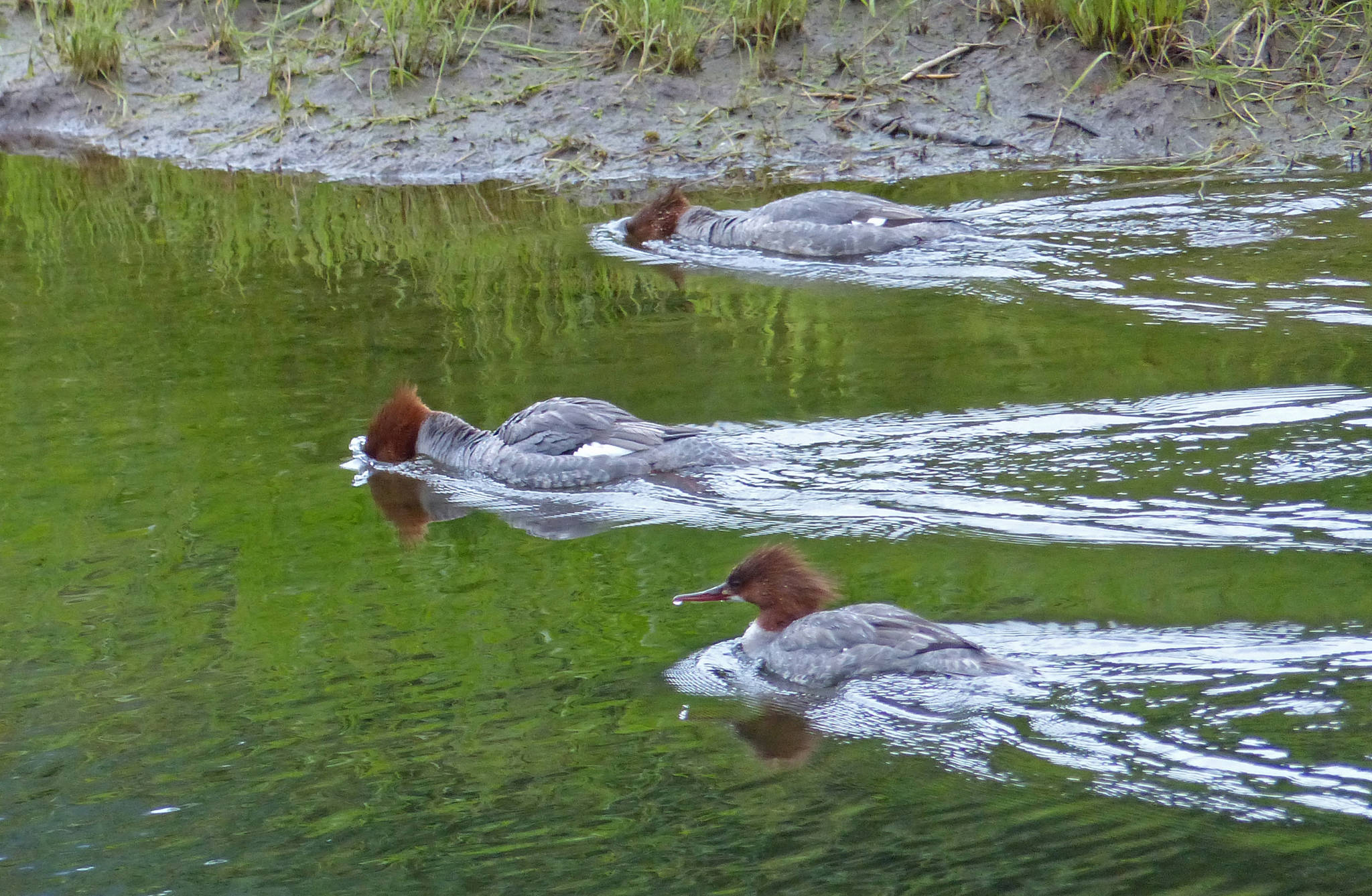Mid-April found us enjoying warm, sunny days, but the nights were still very cool. The ice continued to cover most of my home pond, leaving a narrow margin of open water. A pair of mallards journeyed around the ice, sometimes hopping out to walk over to the bird seed spilled from the feeder that hangs over the pond, and sometimes quarreling with other mallards that tried to horn in.
One day, on Douglas, I sat along a stream near a rocky outcrop where American dippers have often nested in the past. I was hoping to see some early signs of nesting activity—perhaps a male singing, or a pair just hanging out together, or even carrying nesting material. But no luck.
Instead, I saw a small disturbance under a log in the creek. This turned into a river otter, coming down in the current. The otter spent some time in the flat water below the log, foraging intently on prey that it seemed to be digging out of the gravels. Although it came up for air frequently, most of what I saw was its hindquarters and a flailing tail. I had to imagine its front paws scrobbling in the gravels, balanced by the heavy, waving tail. Whatever it was getting was small, needing only a couple of chomps before being swallowed. I don’t know what the prey was, but it could have been sculpin or emerging salmon fry. Eventually, the otter cruised rapidly on downstream in the fast current and disappeared from sight.
While that little show went on, I also enjoyed listening to ruby-crowned kinglets, who sing my favorite spring song. This tiny bird only weighs about six or seven grams (about a quarter of an ounce), but he carols with a big voice, advertising his territory and hoping a winsome female will chose to share it with him.
The next day, a friend and I went along the trail to Camping Cove. This trail deteriorates somewhat as the cabin is approached, but much of the trail has been improved: mud holes filled, and even some steps to pass over muddy, root-y inclines. Here we heard many kinglets, as well as varied thrushes and, near the beaches, song sparrows. On an upper beach we found three robins foraging, two females and a very husky male (whom we called El Guapo). Although robins in other areas had begun to sing, here we heard only creaky little chirps from these three.
We paused for a snack on a rocky headland, looking out toward Mab Island. Down the channel came a group of strange-looking creatures — just the very tips of their noses showing above the water surface. All we could see were half a dozen noses, close together, and headed south, with just some faint hints of narrow-looking bodies behind them. I confess I was flummoxed at first; they looked like nothing else I’d seen before, but they had to be young sea lions, and my naturalist companion was sure of it. I am obviously not very good at identifying nose-tips; I do better with the whole heads showing above the water.
A marmot sunned itself on a rock not far away, occasionally turning to warm another part of its body. All was peaceful until a little gang of rambunctious dogs come by. Then the marmot gave its piercing warning whistle and disappeared. Beach marmots are not uncommon in Juneau, and it would be interesting to compare their ecology and behavior with those of the same species in the alpine zone.
We watched a group of six common mergansers foraging in Akiyama Bight. They were snorkeling; paddling forward with just the bills and eyes underwater, looking for small fish. All of them were in female or juvenile plumage, with brownish crests. It’s hard to tell females from immature males, which don’t get their flashy white sides and green heads until they are two or three years old. These ducks mature more slowly than mallards, which are sexually mature and form pairs when they are one year old.
A few days later, our familiar gray, damp weather returned (with a little snow, yet!). A cold wind was blowing down Gold Creek, but we headed up the trail anyway. We had a report from a reliable scout that the purple mountain saxifrage was in bloom on the cliffs along the Perseverance Trail. Indeed, just before the Horn, high on the cliff, was a bright spot of purple. A bit farther on, we found several clumps of these purple flowers, including one fine spread of many blooming plants. We did not see any bees or other insects during our brief inspections, but some of the stigmas (where pollen is received) of recently opened flowers had a dusting of pollen, although the anthers (containing pollen) of the same flower were not yet open, so this flower had not been pollinated by its own pollen. Later in flower development, the anthers make pollen available for any visiting insect to carry to another flower.
Finding our first purple mountain saxifrage of the season is an annual ritual for some of us, and this search was fulfilling, as expected. Although songbirds were noticeably quiet, perhaps because of the cold wind, we heard sooty grouse hooting from the mountainsides.
• Mary F. Willson is a retired professor of ecology.

